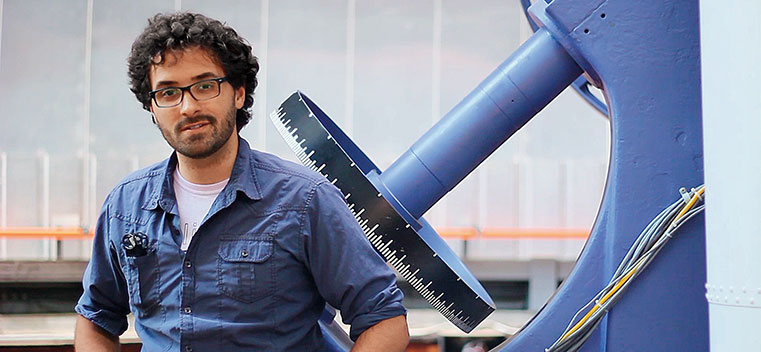
Riding the Gravitational Waves: Carl Rodriguez
What's Up Docs?
Dancing Queen: Dionne Champion
Equitable Education Advocate: Jordan Conwell
Native Voices in Verse: Alanna Hickey
Up on the Roof: Kelly Ksiazek-Mikenas
Pop Culture Detective: Michael Mauskapf
Mixed Messages: Almita Miranda
Stream of Consciousness: Kevin Roche
Riding the Gravitational Waves: Carl Rodriguez
Read more about Northwestern's role in the discovery of gravitational waves in our summer 2016 feature "New Window to the Universe."
Tell us what you think. E-mail comments or questions to the editors at letters@northwestern.edu.
Find Us on Social Media
Gravitational waves are opening new windows into the universe, and Carl Rodriguez studies one source of those waves — black hole mosh pits.
The average density of stars in the Milky Way is very low, with roughly 200 billion stars spread over 100,000 light years, the astrophysicist explains. But in closely packed globular star clusters, collections of hundreds of thousands of stars held together by their own gravity, the density of stars increases dramatically — nearly a million times greater than the density of stars around the sun and its nearest neighbors.
Rodriguez ’16 PhD used Northwestern’s modern supercomputers to run massive simulations of globular star clusters over their 12 billion–year lifetime. He and others have theorized that these globular star clusters are factories for black holes. He likens the center of the cluster to a black hole mosh pit, with hundreds of black holes dancing around each other until two wander too close and get sucked into orbit around each other, forming a binary black hole.
When those black holes eventually crash into each other and merge, they create gravitational waves, ripples in spacetime.
In September 2015 the Laser Interferometer Gravitational-Wave Observatory — the most precise distance-measuring instrument ever built, Rodriguez says — detected gravitational waves for the very first time. The detection was the result of the merger of two massive black holes — 29 and 36 times the mass of the sun, “more massive than any other stellar mass black holes that we had seen before” — 1.3 billion light years away from Earth.
“That merger was the most powerful and energetic event we have ever witnessed as a species,” Rodriguez said in an April 2016 TEDx NorthwesternU talk.
LIGO made a second detection in December 2015. When updates are complete, Rodriguez says, LIGO will detect hundreds of merging black hole binaries every year.
“We’re going to be seeing a ton of these things,” says Rodriguez, who credits his earliest interest in astronomy to Star Trek and conversations with his physicist father. “And gravitational waves, every time you observe a new system, you get to learn something new about the universe. [Each detection is from a] different pair of black holes, which potentially had an entirely different evolutionary history, came from a different part of the universe, maybe even a different formation channel. So it’s really opening up a new window into the universe and letting us see things and understand parts of astrophysics that we never really probed before.”
Rodriguez, who grew up in Shreveport, La., and attended Reed College in Oregon, is now a Pappalardo Fellow in Physics at the Massachusetts Institute of Technology.
“His theoretical work is playing a central role in the interpretation of the first results from LIGO,” says Rodriguez’s thesis adviser, Fred Rasio, the Joseph Cummings Professor of Physics at Northwestern. “Our first of many papers derived from Carl’s work (10 published or submitted as of February) appeared in July 2015 in Physical Review Letters, just weeks before the first LIGO detection. It made clear predictions for the rates and physical properties of the first sources that LIGO would detect, and these turned out to have been right on the mark.”



 Facebook
Facebook Twitter
Twitter Email
Email


